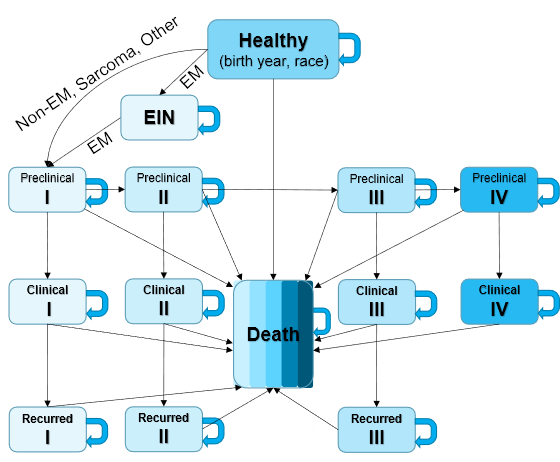MUSIC Icahn School of Medicine at Mount Sinai
Project uterine cancer incidence and mortality by stage, histology, race and age for different birth cohorts. Estimate burden of recurrence (incidence, mortality, impact).
Contact: Chung Yin (Joey) Kong chungyin.kong@mountsinai.org
Summary
The Mount Sinai uterine cancer model (MUSIC) is a microsimulation model. It is derived from an empirically calibrated stochastic continuous-time Markov chain (CTMC). The natural history of uterine cancer is represented by four histologies: endometrioid, non-endometrioid, sarcoma and other. It was developed to simulate synthetic birth cohorts of individuals between 1915 – 2015 from ages 35 to 85. The cycle length is variable but set to 1 month. The 51 health states include healthy, endometrial intraepithelial neoplasia (EIN) as the sole precursor state to endometrioid cancer, as well as preclinical and clinical cancer states with stages I to IV, for each histology. Recurrence is explicitly modeled with recurrent states for initial stages I to III. A cancer-specific death state for each histology and an other-cause of death state is also included. The state scheme is laid out in Figure 1. The model can be used to simulate the population level health effects of different screening, prevention, and treatments, and to gain insight into recurrence in uterine cancer.
MUSIC model and important transitions

Figure 1: States of the MUSIC model and important transitions
MUSIC depends on 11 10-year birth cohorts, born 1915 … 2015, to make accurate predictions and projections between 2000 – 2050. Transition rates depend on age, sex, race, birth-cohort and BMI. Monthly cancer-specific mortality transition rates in clinical and recurred states account for the fast development of uterine cancer, for higher stages and older age. Regression to less advanced states is disallowed, as are the transitions between states associated with different histologies. Competing mortality is modeled using hazard functions for other cause of death.
A distinguishing feature of MUSIC is the modeling of recurrence. The monthly risk of recurrence is informed using a Fine & Gray framework with competing risks in clinical states (death due to uterine cancer, death due to other causes). The risk of recurrence is stratified by age-group, race, stage, and histology. Competing risks in recurred states (death due to other causes/uterine cancer) is also informed using Fine & Grey framework.
The main model calibration target is cancer incidence (SEER), which is stratified by stage, histology, race, and age-group. Calibrated transitions rates (mainly between preclinical and clinical cancer) are obtained using a semi-automatic χ^2-minimization. Risk factors assumption are that a higher BMI leads to a higher incidence of endometrioid cancer, modeled through a higher transition rate healthy to EIN.
MUSIC can predict incidence, mortality, and recurrence trends in the upcoming decades, specifically shedding light on racial disparities, the effect of increasing obesity, as well as relative changes between the incidences of different histologies. Given that uterine cancer is one of the few cancers with increasing incidence in the past decades, MUSIC can be used to investigate public health interventions and policy decisions with the goal of reducing the burden of uterine cancer in the U.S.
Bladder models
- Kystis (Brown) Brown
- COBRAS (Ottawa) Ottawa
- SCOUT (NYU) NYU
Bladder Model Comparison Grid (PDF, 145 KB)
See all Comparison Grids & Profiles (Includes historical versions)
Lung models
- BCCRI-LunCan (BCCRI)
- BCCRI-Smoking (BCCRI)
- LCOS (Stanford)
- LCPM (MGH)
- MISCAN-Lung (Erasmus)
- SimSmoke (Georgetown)
- Smoking-Lung Cancer (Georgetown)
- MULU (Mount Sinai)
- ENGAGE (MDACC)
- YLCM (Yale)
- OncoSim-Lung (CPAC-StatCan)
- LMO (FHCC) (Historical)
Lung Model Comparison Grid (PDF, 161 KB)
See all Comparison Grids & Profiles (Includes historical versions)